List of map network designs
This is a chronologically sorted list of map network designs that have their own articles on Wikipedia or are otherwise noteworthy. Since the number of possible map projections is not limited, there can be no comprehensive list.
Explanations
Projection type
- Cylindrical
- In the standard display, these regularly spaced meridians form uniformly spaced vertical lines and parallels to horizontal lines.
- Pseudocylindrical
- In the standard display, these depict the central meridian and the parallels as straight lines. Other meridians are curves (or possibly straight from the pole to the equator) that run regularly along parallels.
- Conical
- In the standard display, conical (or conical) projections depict meridians as straight lines and parallels as arcs.
- Conical
- In the usual representation, conical projections show the meridians as straight lines and the parallels as circular arcs.
- Pseudoconical
- In the standard display, pseudoconical projections show the central meridian as a straight line, other meridians as complex curves and parallels as arcs.
- Azimuthal
- In the standard display, azimuthal projections show meridians as straight lines and parallels as complete, concentric circles. They are radially symmetric. In any representation (or in any aspect) they preserve directions from the center. This means that great circles through the center point are represented by straight lines on the map.
- Pseudo azimuth
- In the standard display, pseudo-azimuthal projections depict the equator and the central meridian on vertical, intersecting straight lines. They depict parallels to complex curves that run away from the equator and meridians to complex curves that run towards the central meridian. Listed here by pseudocylindrical as they are generally similar in shape and purpose.
- Retroazimuthal
- The direction to a fixed point B (by the shortest route) corresponds to the direction on the map from A to B.
- Other
- Typically calculated from a formula and not based on a specific projection.
- Polyhedral
- Polyhedral maps can be folded into a polyhedral approximation of the sphere, using a special projection to map each surface with little distortion.
properties
- Conform
- Keeps the angles local, which means that local shapes are not distorted and that the local scale is constant in all directions from any chosen point.
- True to area
- The area is retained everywhere.
- Compromise
- Neither conformal nor true to area, but rather a balance designed to reduce overall distortion.
- Equidistant
- All distances from one (or two) points are correct. Other equidistant properties are mentioned in the notes.
- Gnomonic
- All great circles are straight lines.
Table chronologically
| Illustration | year | projection | Originator | Type | properties | Remarks |
|---|---|---|---|---|---|---|
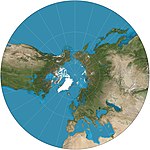 |
580 BC Chr. (Approx.) | Gnomonic projection |
Thales (possibly) |
Azimuthal | Gnomonic | All great circles are mapped on straight lines. Extreme distortion far from the center. Shows less than one hemisphere. |
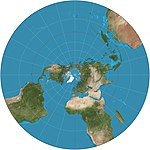 |
200 BC Chr. (Approx.) | Stereographic projection |
Hipparchus * (published) |
Azimuthal | Conform | The map is infinitely large and the outer hemisphere inflates a lot so it is often used as two hemispheres. Maps all the small circles into circles, which is useful for planetary mapping to get the shapes of craters. |
 |
200 BC Chr. (Approx.) | Azimuthal orthographic projection |
Hipparchus * (published) |
Azimuthal | View from an infinite distance. | |
 |
100 (approx.) |
True-to-length cone projection = (equidistant or isometric) = simply conical |
Based on the first projection by Claudius Ptolemy | Conical | True to area | The distances along the meridians are retained as well as the distances along one or two standard parallels. |
 |
120 (approx.) |
Flat map or rectangular or rectangular projection = rectangular projection = parallelogrammatic map |
Marinos of Tire | Cylindrical | True to area | Simplest geometry; Distances along the meridians are retained. Square flat map : special case with the equator as the standard parallel. |
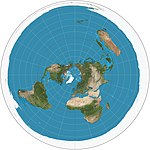 |
1000 (approx.) | Azimuthal Equidistant Projection | Abū Rayḥān al-Bīrūnī | Azimuthal | True to area | Distances from the center are retained. Used as the United Nations emblem that extends to 60 ° S. Used by the USGS in the National Atlas of the United States of America. |
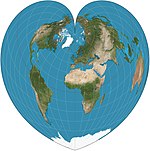 |
1500 (approx.) |
Stab-Werner projection = Werner projection |
Johannes Stabius | Pseudoconical | Equidistant, equal in area | Parallels are equally spaced concentric circular arcs. The distances from the North Pole are correct, as are the curved distances along the parallels and the distances along the central meridian. |
 |
1000 (approx.), 1660 | Nicolosi sphere projection | Abū Rayḥān al-Bīrūnī , re-invented in 1660 by Giovanni Battista Nicolosi | Pseudoconical | Compromise | |
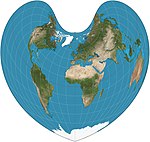 |
1511 | Bonnean projection | Bernardus Sylvanus | Pseudoconical, heart-shaped | True to area | Parallels are equally spaced concentric circular arcs and standard lines. The appearance depends on the reference parallel. General case of Werner Proj. and sinusoidal. |
 |
1514 | Octant projection | Leonardo da Vinci | Polyhedral | Compromise | Projects the globe onto eight octants ( Reuleaux triangles ) without meridians and without parallels. |
 |
1540 | Ortelius oval projection | Battista Agnese | Pseudocylindrical | Compromise | Meridians are circular. |
 |
1569 |
Mercator projection = Wright |
Gerhard Mercator | Cylindrical | Conform | Constant bearing lines ( loxodromes ) are straight, which makes navigation easier. The areas expand with latitude and become so extreme that the map can no longer show the poles. |
 |
1570 (approx.) |
Sinusoidal projection = Sanson-Flamsteed = Mercator true to area |
(several; the first is unknown) | Pseudocylindrical | Equidistant, equal in area | Meridians are sinus curves; Parallels are equally spaced. The aspect ratio is 2: 1. The distances along the parallels are conserved. Jean Cossin von Dieppe was one of the first cartographers to use the sinusoidal that appeared in a 1570 map of the world. |
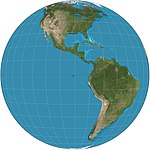 |
1740 | Vertical perspective |
Matthäus Seutter * |
Azimuthal | View from a finite distance. Can only represent less than one hemisphere. | |
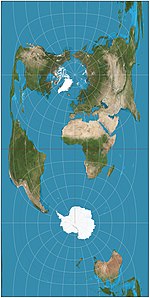 |
1745 |
Cassini projection = Cassini – Soldner |
César François Cassini de Thury | Cylindrical | Equidistant | Across the equidistant projection; the distances along the central meridian are conserved. Distances perpendicular to the central meridian are retained. |
| 1772 | Lambert's cylinder projection | Johann Heinrich Lambert | Cylindrical | True to area | Standard parallel at the equator. Aspect ratio of π (3.14). Basic projection of the cylindrical family of equal surfaces. | |
 |
1772 | Lambert's conformal cone projection | Johann Heinrich Lambert | Conical | Conform | Used in aeronautical charts. |
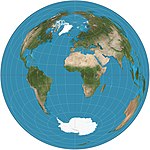 |
1772 | Azimuthal equal area projection | Johann Heinrich Lambert | Azimuthal | True to area | The straight line distance between the central point on the map and any other point is equal to the straight line 3D distance through the globe between the two points. |
 |
1805 |
Mollweide projection = elliptical = Babinet = homolographic |
Carl Brandan Mollweide | Pseudocylindrical | True to area | Meridians are ellipses. |
 |
1805 | Albers cone projection | Heinrich Christian Albers | Conical | True to area | Two standard parallels with little distortion between them. |
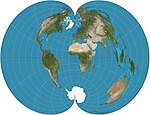 |
1820 (approx.) | American polyconic projection | Ferdinand Rudolph Hassler | Pseudoconical | Compromise | The distances along the parallels as well as the distances along the central meridian are retained. |
 |
1822 |
Gauss-Krüger projection = Gauss-conform = (ellipsoidal) transverse Mercator |
Carl Friedrich Gauss Johann Heinrich Louis Krüger |
Cylindrical | Conform | This transversal, ellipsoidal shape of the Mercator is finite, in contrast to the equatorial Mercator. It forms the basis of the Universal Transverse Mercator coordinate system . |
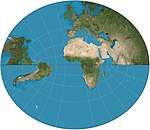 |
1833 | Littrow projection | Joseph Johann von Littrow | Retroazimuthal | Conform | On the equatorial side it shows a hemisphere with the exception of the poles. |
 |
1850 (approx.) | central cylindrical projection | (unknown) | Cylindrical | perspective | Practically unused in cartography because of the strong polar distortion, but popular in panoramic photography , especially for architectural scenes. |
 |
1853 (approx.) | rectangular polyconical projection | National Geodetic Survey | Pseudoconical | Compromise | You can choose the latitude along which the scale is correct. Parallels meet meridians at right angles. |
 |
1855 |
Gall's stereographic projection similar to Braun's stereographic projection |
James Gall | Cylindrical | Compromise | It should resemble the Mercator and at the same time show the poles. Standard parallels at 45 ° N / S. |
 |
1855 |
Gall-Peters-Projection = Gall's Orthographic Projection = Peters |
James Gall ( Arno Peters ) | Cylindrical | True to area | Horizontally compressed version of Lambert's cylinder projection. Standard parallels at 45 ° N / S. Aspect ratio of ~ 1.6. The Balthasart projection is similar with standard parallels at 50 ° N / S. Maps based on the projection are sponsored by UNESCO , and they are also widely used by British schools. |
| 1865 (approx.) | Collignon projection | Edouard Collignon | Pseudocylindrical | True to area | Depending on the configuration, the projection can also depict the sphere on a single diamond or a pair of squares. | |
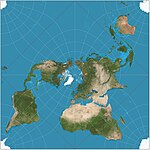 |
1879 | Quincunx map projection | Charles Sanders Peirce | Other | Conform | Mosaics. Can be tiled continuously on one level, with the edge transitions matching up to four individual points per tile. |
 |
1887 | Guyou hemisphere-to-square projection | Émile Guyou | Other | Conform | Mosaics |
 |
1889 | Aitov projection | David Alexandrovich Aitov | Pseudo azimuth | Compromise | Expansion of the modified equatorial azimuthal equidistance map. The boundary is a 2: 1 ellipse. Largely replaced by Hammer. |
 |
1892 |
Hammer projection = Hammer-Aitoff variations: Briesemeister |
Ernst von Hammer | Pseudo azimuth | True to area | Based on the Aitov projection. Changed from the azimuthal equatorial equal-area equatorial map. The boundary is a 2: 1 ellipse. Variants are angled versions, centered on 45 ° N. |
 |
1903 | Hotine's slate Mercator | M. Rosenmund, J. Laborde, Martin Hotine | Cylindrical | Conform | |
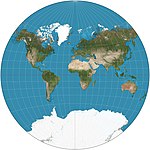 |
1904 | Van der Grinten projection | Alphons J. van der Grinten | Other | Compromise | The border is a circle. All parallels and meridians are arcs. Usually clipped near 80 ° N / S. Standard world projection of the NGS in the years 1922–1988. |
 |
1906 | Eckert I and Eckert II projection | Max Eckert-Greifendorff | Pseudocylindrical | True to area | |
 |
1906 | Eckert III and Eckert IV projection | Max Eckert-Greifendorff | Pseudocylindrical | True to area | Parallels are unequal in distance and scale; outer meridians are semicircles; other meridians are semi-ellipses. |
 |
1906 | Eckert V and Eckert VI projection | Max Eckert-Greifendorff | Pseudocylindrical | True to area | Parallels are unequal in distance and scale; Meridians are half-period sinusoids. |
 |
1909 |
Craig retroazimuthal projection = Mecca projection |
James Ireland Craig | Retroazimuthal | Compromise | It is a modified cylindrical projection. |
 |
1909 | Cahill's butterfly card | Bernard Joseph Stanislaus Cahill | Polyhedral | Compromise | Projects the globe onto an octahedron with symmetrical components and adjacent land masses that can be represented in various arrangements. |
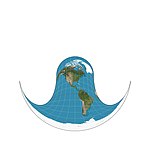 |
1910 | Hammer retroazimuth projection , anterior hemisphere | Ernst von Hammer | Retroazimuthal | ||
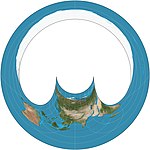 |
1910 | Hammer retroazimuth projection , posterior hemisphere | Ernst von Hammer | Retroazimuthal | ||
 |
1910 | Behrmann projection | Walter Behrmann | Cylindrical | True to area | Horizontally compressed version of Lambert's cylinder projection. Has standard parallels at 30 ° N / S and an aspect ratio of 2.36. |
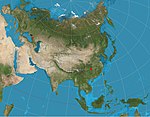 |
1919 | Two-point equidistance projection | Hans Maurer | Azimuthal | Equidistant | Two “control points” can be chosen almost arbitrarily. The two straight line distances from any point on the map to the two control points are correct. |
 |
1921 | Angle-triple projection | Oswald Winkel | Pseudo azimuth | Compromise | Arithmetic mean of the flat map and the Aitoff projection . Standard world projection for the NGS since 1998. |
| 1922 | Roussilhe's oblique stereographic projection | Henri Roussilhe | ||||
 |
1923 | Goode projection | John Paul Goode | Pseudocylindrical | True to area | Hybrid of sinusoidal and Mollweide projection . Usually used intermittently. |
 |
1925 | Adams hemisphere in a square | Oscar Sherman Adams | Other | Conform | |
 |
1929 | Bogg's eumorphic projection | Samuel Whittemore Boggs | Pseudocylindrical | True to area | The equal-area projection, which results from the mean value of the sinusoidal and Mollweide y -coordinates and thereby limits the x -coordinate. |
 |
1929 | Craster parabolic = Reinhold Putniņš P4 |
John Craster | Pseudocylindrical | True to area | Meridians are parabolas. Standard parallels at 36 ° 46′N / S; Parallels are unequal in distance and scale; 2: 1 aspect. |
 |
1932 | Wagner VI projection | KH Wagner | Pseudocylindrical | Compromise | Equivalent to Kawraiski VII compressed by a factor of vertically . |
 |
1935, 1966 | Loximuthal projection | Karl Siemon, Waldo Rudolph Tobler | Pseudocylindrical | From the indicated center the lines of constant bearing ( loxodromes ) are straight and of the correct length. Generally asymmetrical around the equator. | |
 |
1937, 1944 | quartic authalic projection | Karl Siemon Oscar Adams |
Pseudocylindrical | True to area | The parallels are uneven in spacing and scale. No distortion along the equator. Meridians are fourth order curves. |
 |
1939 | Kawraiski VII projection | Vladimir Vladimirovich Kawraiski | Pseudocylindrical | Compromise | Evenly distributed parallels. Equivalent to Wagner VI horizontally by the factor . compressed. |
 |
1941 | Wagner VII projection = Hammer Wagner |
KH Wagner | Pseudocylindrical | True to area | |
 |
1942 | Miller cylinder projection | Osborn Maitland Miller | Cylindrical | Compromise | It should resemble the Mercator while showing the poles. |
 |
1943 |
Dymaxion projection = Fuller projection |
Richard Buckminster Fuller | Polyhedral | Compromise | World map on the surface of an icosahedron that unfolds and can be flattened to two dimensions. The flat card is heavily broken up to preserve shapes and sizes. |
 |
1943 | Armadillo projection | Erwin Raisz | Other | Compromise | |
 |
1948 |
Atlantis projection = Mollweide transverse |
John Bartholomew | Pseudocylindrical | True to area | Oblique version of the Mollweide projection |
 |
1949 | McBryde – Thomas flat polar quartic = McBryde-Thomas # 4 |
Felix W. McBryde, Paul Thomas | Pseudocylindrical | True to area | Standard parallels at 33 ° 45′N / S; Parallels are unequal in distance and scale; Meridians are fourth order curves. Distortion-free only where the standard parallels intersect the central meridian. |
 |
1951 |
Hölzel projection = Hölzel planisphere |
Ed. Hölzel | Pseudocylindrical | With parallel, equally spaced degrees of latitude of unequal length, the poles being shown in the form of a polar line. The longitudes are shown as sine curves up to a latitude of 80 °, and further north as an ellipsoid to the pole. It is neither conformal nor conformal, and no point on the map is free of distortion. Variant of the Eckert V projection; First used for the Kozenn Atlas of 1951 and distributed in Austria to this day. | |
 |
1953 |
Bertin projection = Bertin-Rivière = Bertin 1953 |
Jacques Bertin | Other | Compromise | Projection in which the compromise is no longer homogeneous, but is modified for a greater deformation of the oceans in order to achieve a smaller deformation of the continents. Often used for French geopolitical maps. |
 |
1963 | Robinson projection | Arthur H. Robinson | Pseudocylindrical | Compromise | Calculated by interpolating tabular values. Used by Rand McNally since its inception and used by NGS in 1988-1998. |
| 1963 | Equally differential polyconical projection in terms of width | China State Bureau of Surveying and Mapping | Pseudoconical | Compromise | Polyconical: Parallels are not concentric circular arcs. | |
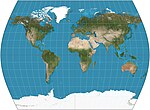 |
1965 | The Times | John Muir | Pseudocylindrical | Compromise | Standard parallels 45 ° N / S. Parallels based on Gallic stereography, but with curved meridians. Developed for Bartholomew Ltd., The Times Atlas. |
 |
1965 | Lee conformal world in a tetrahedron | LP Lee | Polyhedral | Conform | Projects the globe onto a regular tetrahedron. Mosaics. |
 |
1973 | Tobler hyperelliptic projection | Waldo Rudolph Tobler | Pseudocylindrical | True to area | A family of map projections which, as special cases, include the Mollweide projection, the Collignon projection and the various cylindrical projections of equal area. |
| 1973 | four-sided spherical cube | F. Kenneth Chan, EM O'Neill | Polyhedral | True to area | ||
 |
1975 | Cahill-Keyes projection | Gene Keyes | Polyhedral | Compromise | Projects the globe onto a truncated octahedron with symmetrical components and adjoining land masses that can be represented in various arrangements. |
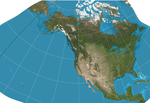 |
1982 | GS50 projection | John P. Snyder | Other | Conform | Specifically designed to minimize distortion when viewing all 50 US states . |
 |
1994 | Strut 1995 projection | Daniel "daan" strut | Pseudo azimuth | True to area | Formulated using other equal area map projections than transformations. |
 |
1996 | Waterman butterfly projection | Steve Waterman | Polyhedral | Compromise | Projects the globe onto a truncated octahedron with symmetrical components and adjoining land masses that can be represented in various arrangements. |
 |
1997 | HEALPix | Krzysztof M. Górski | Pseudocylindrical | True to area | Hybrid of Collignon + Lambert's cylinder projection. |
| Link to the picture | 1999 | Authagraph projection | Hajime Narukawa | Polyhedral | Compromise | Almost true to area. Mosaics. |
 |
2002 | Hobo Dyer projection | Mick Dyer | Cylindrical | True to area | Horizontally compressed version of Lambert's cylinder projection. Trystan-Edwards and Smyth equilateral projections (= Craster rectangle) with standard parallels at about 37 ° N / S are very similar. Aspect ratio of ~ 2.0. |
 |
2003 | Bottomley projection | Henry Bottomley | Pseudoconical | True to area | An alternative to the Bonnean projection with a simpler overall shape. Parallels are elliptical arcs. The appearance depends on the reference parallel. |
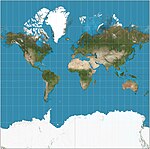 |
2005 | Web Mercator projection | Cylindrical | Compromise | Mercator variant that ignores the earth's ellipticity for quick calculations and reduces the latitudes to around 85.05 ° for presentations. De facto standard for web mapping applications. It is used by virtually all major online map providers, including Google Maps, Mapbox , Bing Maps , OpenStreetMap , Mapquest , Esri , and many others. | |
| 2008 | Myriahedral projections | Jarke J. van Wijk | Polyhedral | True to area | Projects the globe onto a myriahedron: a polyhedron with a very large number of faces. | |
 |
2011 | Natural Earth projection | Tom Patterson | Pseudocylindrical | Compromise | Calculated by interpolating tabular values. |
 |
2018 | Equal Earth projection | Bojan Šavrič, Tom Patterson y Bernhard Jenny | Pseudocylindrical | True to area | Inspired by the Robinson projection , but maintains the relative size of the surfaces. |
* The first known popularizer / user and not necessarily the originator.
literature
- John P. Snyder: Map projections: A working manual . In: Map projections - A working manual (= US Geological Survey Professional Paper), Volume 1395. US Government Printing Office, Washington, DC 1987, doi : 10.3133 / pp1395 (accessed August 4, 2020).
- John P. Snyder, Philip M. Voxland: An Album of Map Projections (= US Geological Survey Professional Paper), Volume 1453. US Government Printing Office, Washington, DC 1989, doi : 10.3133 / pp1453 (accessed August 4, 2020) .
Individual evidence
- ^ Snyder, John P .: Flattening the earth: two thousand years of map projections . University of Chicago Press , 1993, ISBN 0-226-76746-9 , p. 1.
- ↑ Furuti, Carlos A. Conic Projections: Equidistant Conic Projections
- ↑ http://www.csiss.org/map-projections/Polyconic/Nicolosi_Globular.pdf
- ^ Donald Fenna: Cartographic Science: A Compendium of Map Projections, with Derivations . CRC Press, 2006, ISBN 978-0-8493-8169-0 , p. 249.
- ^ Jean Cossin, Carte cosmographique ou Universelle description du monde avec le vrai traict des vents , 1570.
- ↑ Gall is credited with describing the projection in 1855 at a science congress.
- ^ Higgins, Hannah B. The Grid Book . Cambridge, Massachusetts: MIT Press, 2009. ISBN 9780262512404 p. 94. “Embroiled in controversy from the start, the map is nonetheless widely used in the British school system and is promoted by the United Nations Educational and Scientific Cultural Organization (UNESCO) because of its ability to communicate visually the actual relative sizes of the various regions of the planet. "
- ^ Philippe Rivière: Bertin Projection (1953) . In: visionscarto . October 1, 2017.
- ↑ Our Map Data . MapBox .: "Mapbox supports the popular Web Mercator projection, and currently does not support any other projections for display."
- ^ Sarah E. Battersby, Michael P. Finn, E. Lynn Usery, Kristina H. Yamamoto: Implications of Web Mercator and Its Use in Online Mapping . In: Cartographica . 49, No. 2, 2014, p. 92. doi : 10.3138 / carto.49.2.2313 .
- ↑ Jarke J. van Wijk. "Unfolding the Earth: Myriahedral Projections". [1]
- ↑ Carlos A. Furuti. "Interrupted Maps: Myriahedral Maps". [2]
Web links
- Description of the different map projections (links to each projection on the left side of the page - in English)
- List of map projections (with examples )
- Visual map projection list
